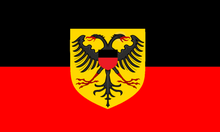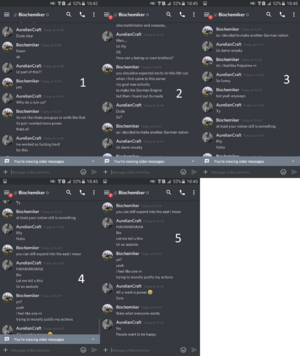Holy Roman Empire of the German Nation
Description
The Holy Roman Empire of the German Nation (German: Heiliges Römisches Reich Deutscher Nation, Latin: Sacrum Imperium Romanum Nationis Germanicæ) was a Germanic nation located in Central Europe. Even though it was called the Holy Roman Empire, the empire itself had no claims whatsoever on the city of Rome.
Political Structure
The Holy Roman Empire had a Kaiser (Emperor) as the ruling head of state, there was also a Kanzler (Chancellor) which supervises the nation and help make some important decisions as the empire was a constitutional monarchy. The HRE in EMC did not use the Elective Monarchy structure as the first Kaiser of HRE believes it was too risky to do so. (instead, it was a mix of Constitutional Monarchy and Elective Monarchy). But Prince-Electors still exist, their role was to help collect imperial tax and vote on decisions in the Reichstag (Imperial Diet). (note: Imperial Elections still exist however, in this case to appoint temporary rulers for various reasons)
There are 7 Prince-Electors within the Holy Roman Empire, each coming from a different circle, or province. The circles of the Holy Roman Empire includes: The Brandenburg Circle, The Bavarian Circle, The Austrian Circle, The Westphalian Circle, The Lower Saxon Circle, The East Prussian Circle, The Schlesien Circle, The Wurttemberg Circle, and the Pommern Circle. Each circle had their own hierarchy of Princes, Barons, Dukes, so on, all of them led by the Prince-Elector of the respective circle. A local noble can ignore the Prince-Elector if and only if they have been bestowed Imperial Immediacy by the Kaiser of the Holy Roman Empire, this will make the person responsible only to the Kaiser (only takes orders from him). Each Prince-Elector are required to collect taxes from their citizens and pay parts of it to the Kaiser and the Central Government. Taxes are collected weekly, if a circle/province did not pay taxes then its votes will be counted as zero in the Reichstag for the duration of that week until they pay their taxes. The Kaiser had the authority to appoint and decommission Prince-Electors.
There are 2 supreme courts in the HRE, the Imperial Chamber Court (Reichskammergericht) and the Aulic Council (Reichshofrat).
Each major imperial city had a palace (more like a fortified mansion rather than a palace) known as the Kaiserpfalz, these mansions are secondary seats of the Holy Roman Emperor and used as temporary residences.
Electorates
The Holy Roman Empire had 7 Electorates, each led by a Prince-Elector, the electors are responsible for voting for the multiple decisions, and sometimes they vote for the next Kaiser, such an election was known as an Imperial Election.
List of Electorates (Note: Electorates did not necessarily have to have the same names as their corresponding circles/provinces):
The Electorate of Bavaria, The Electorate of Austria, The Electorate of Westphalia, The Electorate of Schlesien, The Electorate of Baden, The Electorate of Lower Saxony, The Electorate of Pommern
Military
There are two kinds of wars the Holy Roman Empire can face, a provincial war, or a Reichskrieg (Imperial War). In a provincial war, only the provoked province and the aggressor (or vice versa) will be included in the official war, other provinces may join if they want to but the Kaiser and the Reichstag, under the supervision of the Kanzler, may declare Reichskrieg if situation worsens. A Reichskrieg (Imperial War), was a war in which the entirety of the Holy Roman Empire must fight, all provinces are called into war and the national army (Reichsarmee) will be mobilized.
As of the 2nd of August, 2019, on the day of the establishment of the Holy Roman Empire and the coronation of Dr_Biochemist as the first Holy Roman Emperor of the German People, the empire had a military force of 12 people (this was the number of troopers in the Reichsarmee), and each regional province had its own contingent of about 1~3 soldiers. This number was expected to increase quickly as time passed.
History
Stabilization
After the HRE was made, its first Kaiser decided to enact multiple policies to stabilize the nation before dealing with other Germanic nations. This includes the hiring of military advisers and the opening of a shop in Regensburg. On the 6th August, Dr_Biochemist temporarily handed over the throne to Punchy of Vienna because of in real life reasons, aka he needs to go on a trip. (the result was voted on by the 7 Electorates). On the 4th August, 2019, the town of Lundegrende joined the Empire, and on the 5th August, 2019, the Shop of Regensburg had opened.
Trivia
- The Holy Roman Empire was created entirely for personal power. Photographic evidence exists of Biochemist claiming he only made the HRE for personal gain, and this can be seen in how the HRE uses a Constitutional Monarchy system rather than an Elective Monarchy system like it did in real life.
- The Holy Roman Empire, before the 2nd of August, was known as Burgundy, and its capital city was Ghent, led by EchoOcelot, a Praetor of the Greater Roman Empire.
- The Holy Roman Empire was declared a puppet of the German Empire on the 28th of August by Franz I (PunchyIsWoke).

